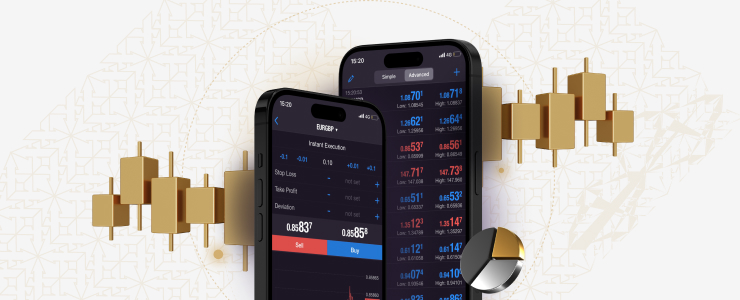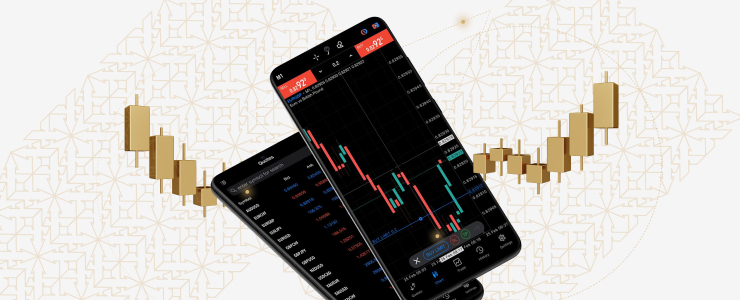With online trading more accessible than ever before, many turn to it as an additional income route. Whether you’re a business professional, stay-at-home parent, or simply someone with a bit of extra time on their hands, you may want to learn how to trade to bolster your finances.
However, the finance world can definitely feel unwelcoming. Professional terminology, conflicting sources, and informational overload are real threats. Together, these can be enough to dissuade even otherwise diligent people from entering the trading world. Our aim is to fix that.
In today’s text, we’ll provide a clear, actionable path that you can follow to start trading. This will include specific examples to help set expectations and guide you through your initial experience.
Where can I trade?
By far the most accessible way to trade for the average person is via an online brokerage. You can start trading right here on Xlence, but you may want to explore other options as well. Here are some things to keep in mind while searching:
Safety
Choosing a secure broker is crucial. In general, you should look for:
- Regulation from a reputable authority
- Clear company profile (history, online presence)
- Good online relations (reviews, sponsorships)
- Positive user feedback
- A solid customer support structure.
You should avoid:
- Unregulated brokers or especially those who falsify regulation
- Companies with no background or relations
- Brokerages with alarming user reports (withholding withdrawals, ghosting)

Asset and funding method availability
You may want to trade stocks like in the movies, or maybe you’ve heard online forex market is where the real potential is. Perhaps you’ve heard of a finance trend you’d like to explore. Either way, most brokerages will have their trading instrument list posted, just make sure your preferred asset is on there.
The same goes for funding methods, you’ll want to deposit and withdraw money smoothly, so it’s good to have a broker that offers your preferred payment method.
Pricing and accounts
Trading is controlled by your finances and the end goal is to increase profit. You’ll want to make sure that you’re okay with the broker’s deposit requirements for accounts, and generally, you’ll want the tightest spreads/lowest fees available.
Brokerage type
In general, online brokers fall into two categories, traditional and CFD brokers. The former usually only let you trade on domestic markets, have higher fees comparatively, but give you ownership over the asset you purchase. Conversely, CFD brokers can access top global assets, and incur lower costs but come without underlying asset ownership.
Since, at this point in your trading journey, asset ownership doesn’t really make a difference, CFD brokers are the clear winner for non-US traders.
Looking for a broker in practice
Here, we’ll outline some specific steps that you may take while looking for a broker.
- In your search engine, type: “Best online brokers”. You may want to add your country in the search term as well.
- In all likelihood, one of the results will be a list.
- Browse the list and find an option that piques your interest.
- Go on the broker’s website and find regulation information, usually in the footer.
- Cross-reference the registration number to the regulator’s database to ensure validity.
- Check account minimums, asset availability, support, and fee structure on the broker’s website.
- Search “Broker name review” to find what professional outlets think. You may find alternatives worth considering here.
- Search “Broker name trust” to find what users think.
- Repeat until you find an option you’re satisfied with.
Note that all this may take quite a bit of time in some circumstances. However, we believe that prioritising quality over speed is always worth it, especially if you’re just starting out.
Opening an account
To start trading, your options are to open a demo account (if the broker offers it) or to open a live account.
A demo account is an account with virtual funds that you can’t withdraw. That means that any gains or losses that happen won’t have an impact on your finances. A demo account is an invaluable practice tool. Newer traders can get used to platform features and test out trading without undertaking any financial risk.
A live account is where you trade with your real money. Opening a live account with most brokers takes a while longer, as traders need to undergo certain processes dictated by financial regulators. While the extra wait can be frustrating, these processes ensure that both online brokers and clients operate in a safe environment with an even playing field. Additionally, it’s important to keep in mind that most brokers have a specific deposit threshold for a live account.
In most cases, newer traders will want to open a demo account, learn the ropes, and then progress to a live trading account.

The account opening process:
Below you can see outlined exactly what you can expect during the registration process for an online broker:
- Initial registration, which includes basic personal information (login credentials, location, age, full name, contact data).
*This is when you’ll be able to use your demo account with most brokers.
- KYC (Know your customer), which involves sending proof of identity (government-issued ID) and residence (utility bill). It may also involve a face check as additional proof of identity.
- Making your first deposit, which will happen through the broker’s payment
ssystem. This process may not be instant depending on your payment method and the broker’s processing time.
After you complete these steps, you’ll have your trading accounts and you’ll be ready to enter the markets.
Understanding trading platform features
All trading goes through trading platforms. Depending on your broker and your preferences, you’ll usually be able to use your platform as a terminal (download it and install it on your computer), web platform (through a computer browser), or mobile app. A broker may offer multiple platforms, choosing the right one comes down to experimenting and seeing what feels right. We suggest MetaTrader 4 (MT4) if it’s available, since it’s widely spread, so if you learn it, you’ll likely be able to use it if you change brokers in the future.
Admittedly, platforms often boast some complex features, and explaining these is beyond the scope of this text. However, we will give you explanations for the core features of any platform. That way, when you go on your demo account, you’ll be able to start figuring out what you’re interested in.
Asset list
Usually in the upper left-hand corner, the asset list shows the assets you can trade. Normally, they’ll be sorted into categories and you’ll be able to sort the assets you’re interested in into a custom watchlist. Clicking an asset should bring up its chart.
Charts
Charts show you the price movement of the asset you’re looking at, the X axis representing time and the Y axis the price. To change the time you’re looking at, you can usually zoom out by scrolling, or select a predetermined timeframe (1 minute, 15 minutes, an hour, a day, a month) on the platform. There are multiple chart types, with lines being the most intuitive, and candlesticks the most detailed.

Buying and selling
Buying and selling assets is a crucial part of trading. To buy, you’ll be able to either double-click an asset from your asset list or right-click it and press new order. This will bring up a menu (usually on the upper right-hand side) that will let you place a buy order, sell order, and set up take profits and stop losses. Of course, you’ll set the trade volume here (how much of the asset you’re placing the order for). A buy order is for when you expect the price to rise, and a sell order is for when you expect it to fall.
The trade will then go to your order window, usually at the bottom of the screen. You’ll be able to close the position there and collect your winnings or cut your losses. Voila! You’re officially a trader.
Take profits, stop losses
One last thing to mention before we wrap up is the importance of the take profits (TP) and stop losses (SL) features. Essentially, these features close your position once it reaches a certain point. It’s very important to get into the habit of setting these, since they prevent debilitating losses in swings, and help control driving emotions in trading, like fear and greed. These two features are at the core of every risk management strategy, so when you’re starting, we recommend setting them for every trade.
Learning how to trade may sound intimidating, but once you have a clear path and start breaking the process apart, you’ll see that it’s fairly simple. If you’re interested in expanding your trading knowledge further, Xlence’s blog covers a wide variety of key topics that you can use to build trading fundamentals. Good luck and remember to go at your own pace – the markets won’t disappear within a few days.
Disclaimer:This information is not considered investment advice or an investment recommendation, but instead a marketing communication.




